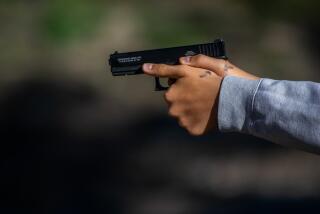Progress Gives Us Great New Handgun--Hijacker Special
- Share via
In a terrifying example of progress outpacing common sense, the handgun industry is poised on the brink of the first major change in concealable firearms in this century--plastic handguns.
Incorporating resilient, lightweight, corrosion-proof polymers into their design, plastic handguns will render metal detectors ineffective. When broken down into their component pieces, they will easily deceive X-ray machines.
This new generation of handgun will appeal to numerous gun aficionados for a variety of reasons, but will be best suited for one in particular: terrorists. Unfortunately, we already have a glimpse of the future. Austrian plastics manufacturer Gaston-Glock has developed the Glock 17, the first handgun in the world to employ plastic in its structural design. This “handgun of the future” is almost half plastic. Only three of its major components are metal: the barrel, slide and spring. Including its clip, the 33-piece gun weighs only 23 ounces and can be field-stripped and reassembled without tools. It is currently the standard sidearm of the 25,000-member Austrian army.
Although Federal Aviation Administration officials admit that the Glock 17 is less detectable than an all-metal handgun, they maintain that the weapon can still be spotted by standard security devices. Others aren’t so sure.
According to columnist Jack Anderson, a Pentagon security expert has already shown how easily the Glock 17 can be smuggled aboard an airliner. By stripping the weapon down and disguising its metal components in his carry-on luggage, he twice carried the weapon through security checkpoints at the Washington National Airport.
Not surprisingly, Libyan leader Moammar Kadafi has expressed interest in acquiring 100 to 300 Glock 17s.
Glock plans not only to export the weapon but also to license and supervise the installation of local assembly or manufacturing plants in countries “where local demand by official customers (military/police)” justifies feasible operation. U.S. importation and distribution of the Glock 17 began in late January, and the company plans to begin producing the handgun here by the end of the year.
But it’s clear that Glock has no intention of restricting sales to “official” customers. A distributor’s ad for the Glock 17 has already appeared in Shotgun News, the catalogue of firearms. The ad’s most eye-catching feature isn’t a warning concerning sales to “official” customers--there is no warning--but just the weapon’s “introductory” price.
America’s handgun manufacturers and dealers have hailed plastic as the savior that is necessary to rescue their industry’s stagnating sales.
In the April, 1985, issue of America Firearms Industry, Andy Molchan, the president of the National Assn. of Federally Licensed Firearms Dealers, guarantees that, although the Austrian handgun uses a metal barrel, “the American model will be 100% plastic. Polymer is without question going to be the material of the future . . . . If a 100%-plastic gun works, this would be great for sales. What this does is make everything that has been produced in this century obsolete. This is exactly what our industry desperately needs. This will give us a whole new and real reason to resell every hunter and shooter in America. Will people take to plastic guns? People will take to anything that is better.”
In the January, 1986, issue, Molchan reported that calls from U.S. dealers were coming into Glock by the hundreds.
Common sense would decree that a nation girding itself for terrorist assault would move swiftly to stop the importation and domestic production of this new breed of handgun. But President Reagan’s staunch stand against international terrorism is second only to his opposition to handgun control--of any type. Or, to anticipate the National Rifle Assn., “Plastic handguns don’t kill airline passengers, terrorists do.”
Thankfully, New York Democratic Reps. Robert J. Mrazek and Ted Weiss place the public’s welfare over the handgun industry’s private concerns. Recognizing that handgun manufacturers have never been known for their social conscience, Mrazek and Weiss are co-sponsors of the Terrorist Firearms Prevention Act of 1986.
In effect, the bill would require that any new line of firearm marketed in the United States after Jan. 1, 1986, be readily detectable by standard security devices such as X-ray machines and metal detectors. The bill is pending before the House Judiciary Committee.
As hazardous as it may be, the Glock 17 is merely the Sputnik of plastic handguns. As technology improves, this new generation of handgun can only advance to the point where it will be virtually invisible to standard security devices.
In the same way that inexpensive, easily concealable Saturday-night specials are best suited for criminal use, technology has now given us a category of handgun ideal for terrorists intent on invading our airliners, public buildings and government offices: the hijacker special.
More to Read
Sign up for Essential California
The most important California stories and recommendations in your inbox every morning.
You may occasionally receive promotional content from the Los Angeles Times.













